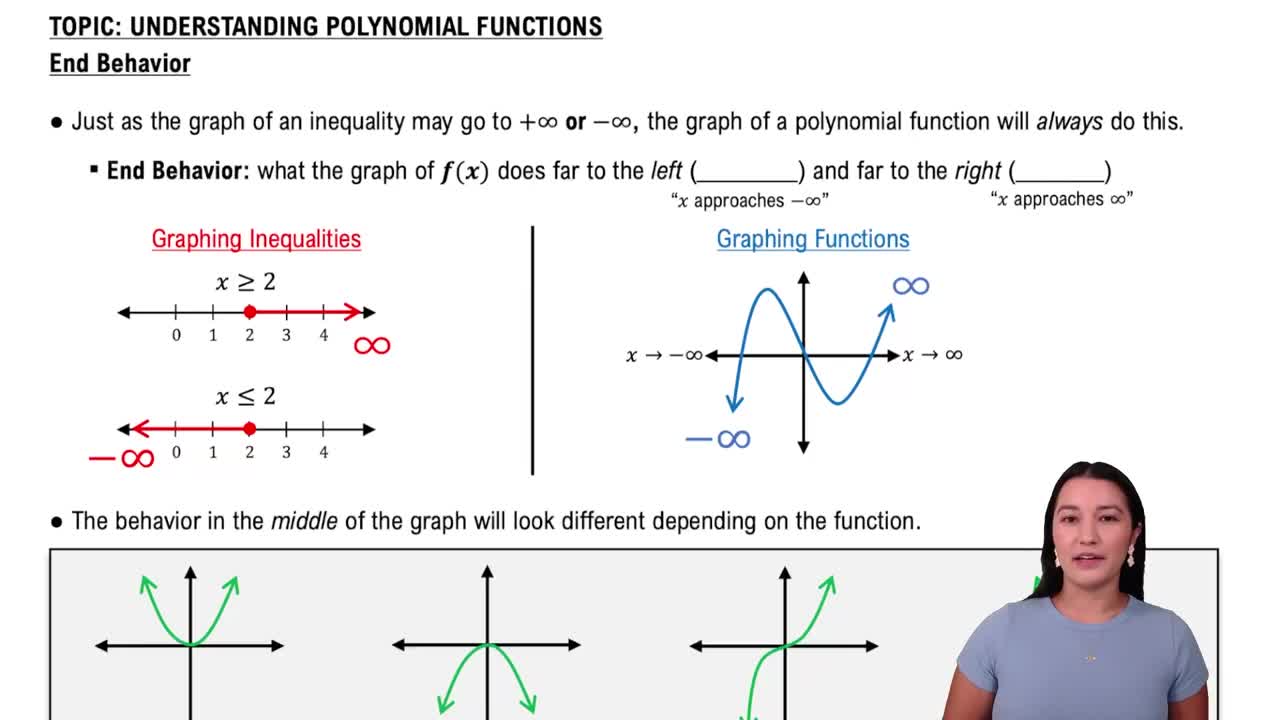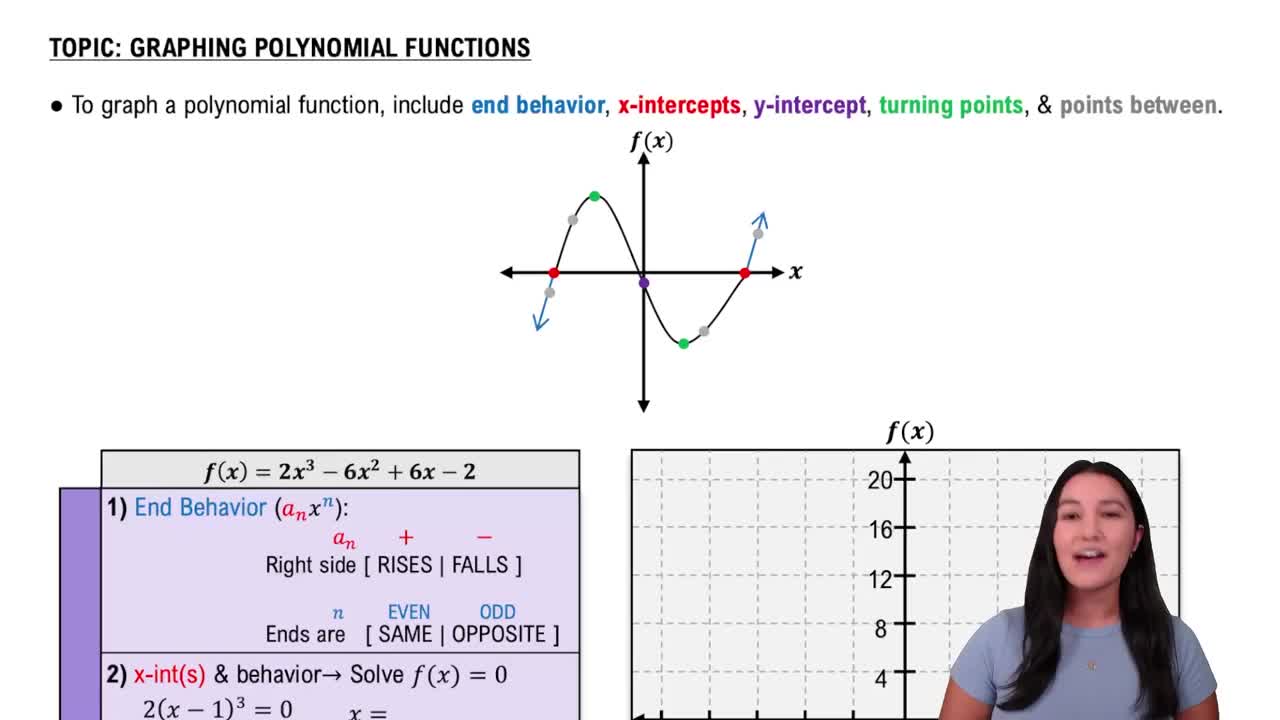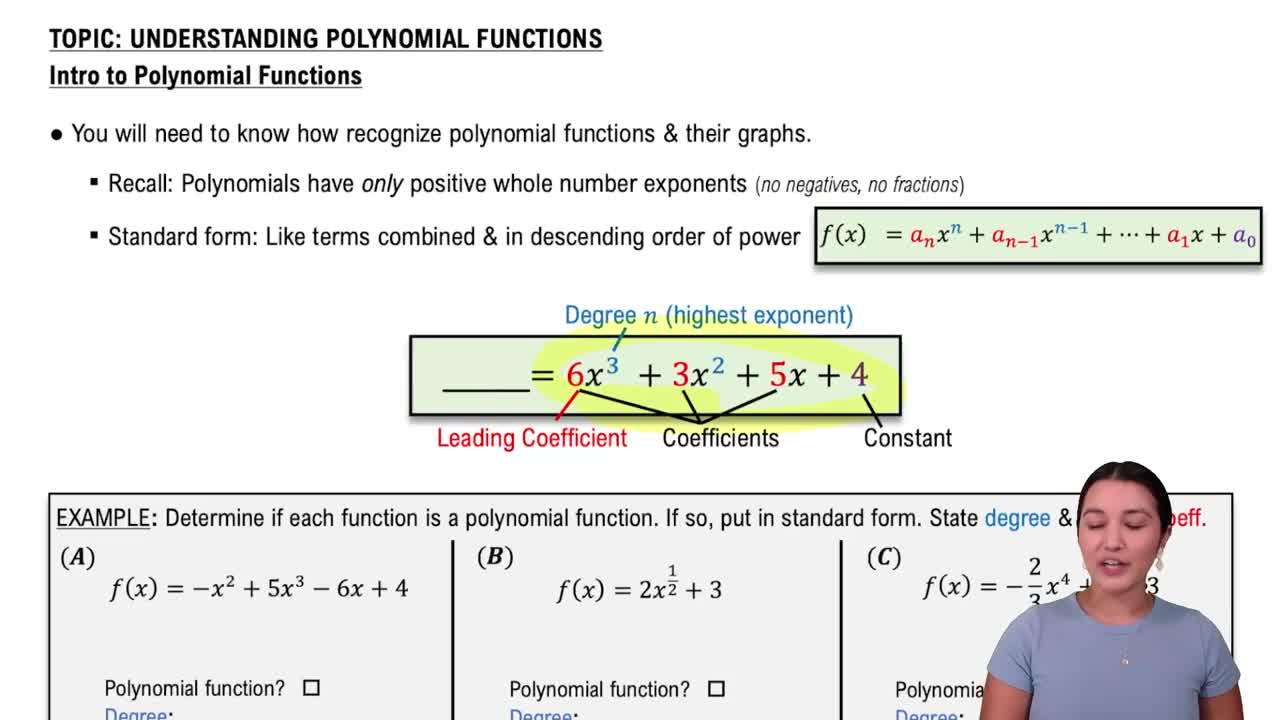Table of contents
- 0. Review of Algebra4h 16m
- 1. Equations & Inequalities3h 18m
- 2. Graphs of Equations43m
- 3. Functions2h 17m
- 4. Polynomial Functions1h 44m
- 5. Rational Functions1h 23m
- 6. Exponential & Logarithmic Functions2h 28m
- 7. Systems of Equations & Matrices4h 6m
- 8. Conic Sections2h 23m
- 9. Sequences, Series, & Induction1h 19m
- 10. Combinatorics & Probability1h 45m
4. Polynomial Functions
Understanding Polynomial Functions
Problem 19b
Textbook Question
In Exercises 19–24, (a) Use the Leading Coefficient Test to determine the graph's end behavior. (b) Determine whether the graph has y-axis symmetry, origin symmetry, or neither. (c) Graph the function. f(x) = x^3 - x^2 - 9x + 9
 Verified step by step guidance
Verified step by step guidance1
**Step 1: Use the Leading Coefficient Test**: Identify the leading term of the polynomial function. For \( f(x) = x^3 - x^2 - 9x + 9 \), the leading term is \( x^3 \). Since the degree is odd and the leading coefficient is positive, the end behavior of the graph is: as \( x \to -\infty \), \( f(x) \to -\infty \) and as \( x \to \infty \), \( f(x) \to \infty \).
**Step 2: Check for y-axis symmetry**: A function has y-axis symmetry if \( f(-x) = f(x) \) for all \( x \). Substitute \( -x \) into the function: \( f(-x) = (-x)^3 - (-x)^2 - 9(-x) + 9 = -x^3 - x^2 + 9x + 9 \). Since \( f(-x) \neq f(x) \), the function does not have y-axis symmetry.
**Step 3: Check for origin symmetry**: A function has origin symmetry if \( f(-x) = -f(x) \) for all \( x \). Using the expression for \( f(-x) \) from Step 2, compare it to \( -f(x) = -(x^3 - x^2 - 9x + 9) = -x^3 + x^2 + 9x - 9 \). Since \( f(-x) \neq -f(x) \), the function does not have origin symmetry.
**Step 4: Determine symmetry**: Since the function has neither y-axis symmetry nor origin symmetry, it has neither symmetry.
**Step 5: Graph the function**: Plot the function \( f(x) = x^3 - x^2 - 9x + 9 \) using the end behavior and any critical points or intercepts to guide the shape of the graph.
Recommended similar problem, with video answer:
 Verified Solution
Verified SolutionThis video solution was recommended by our tutors as helpful for the problem above
Video duration:
5mPlay a video:
Was this helpful?
Key Concepts
Here are the essential concepts you must grasp in order to answer the question correctly.
Leading Coefficient Test
The Leading Coefficient Test is a method used to determine the end behavior of polynomial functions based on the sign and degree of the leading term. For a polynomial of the form f(x) = ax^n, where 'a' is the leading coefficient and 'n' is the degree, if 'n' is even, the ends of the graph will either both rise or both fall, depending on the sign of 'a'. If 'n' is odd, one end will rise while the other falls. This test helps predict how the graph behaves as x approaches positive or negative infinity.
Recommended video:

End Behavior of Polynomial Functions
Symmetry in Graphs
Symmetry in graphs refers to the property of a function where its graph remains unchanged under certain transformations. A function has y-axis symmetry if f(-x) = f(x), indicating it is even, and it has origin symmetry if f(-x) = -f(x), indicating it is odd. Identifying symmetry can simplify the graphing process and provide insights into the function's behavior, particularly in determining the presence of certain features like intercepts and turning points.
Recommended video:
Guided course

Graphs and Coordinates - Example
Graphing Polynomial Functions
Graphing polynomial functions involves plotting points based on the function's values and analyzing its features such as intercepts, turning points, and end behavior. Key steps include finding the roots of the polynomial, determining the y-intercept, and using the Leading Coefficient Test to understand the end behavior. Additionally, understanding the degree of the polynomial helps predict the number of turning points, which are critical for sketching an accurate graph.
Recommended video:

Graphing Polynomial Functions

 6:04m
6:04mWatch next
Master Introduction to Polynomial Functions with a bite sized video explanation from Callie
Start learningRelated Videos
Related Practice


















